Ravi Rohini Pravesha Chakra
Forecasting rainfall has been one of the primary functions of Jyotish. In the days of yore when the economy was primarily agricultural, planning depended on accurately forecasting rainfall and crop. Various methods are available in Jyotish for this purpose and include (1) Ravi Rohini Pravesha Chakra[1] (2) Rohini Chakra (3) Saptanädi Vedha Chakra (4) Jala Nädi Chakra (5) Trinädi chakra etc.
The Ravi Rohini Pravesha Chakra is given below:
Table 1 Rohini Pravesha Chakra
| Day | 1 | 2 | 3 | 4 | 5 | 6 | 7 | 8 | 9 | 10 | 11 | 12 | 13 |
| Rain | 72 | 50 | 45 | 42 | 39 | 34 | 21 | 30 | 28 | 24 | 21 | 16 | 12 |
#1: Rohini Pravesha
Rohini nakshatra is the fourth nakshatra reckoned from Aswini and extends from Taurus 10*-23*20’. The sun traverses this nakshatra in 13 days as reckoned from the date of its entry (day-1). Depending on the day from this Rohini entry, if even a meager rain is noticed, the starting date of rainfall (monsoon season) is predicted using the Rohini Pravesh chakra.
Chart 1 Rohini Pravesh 2002
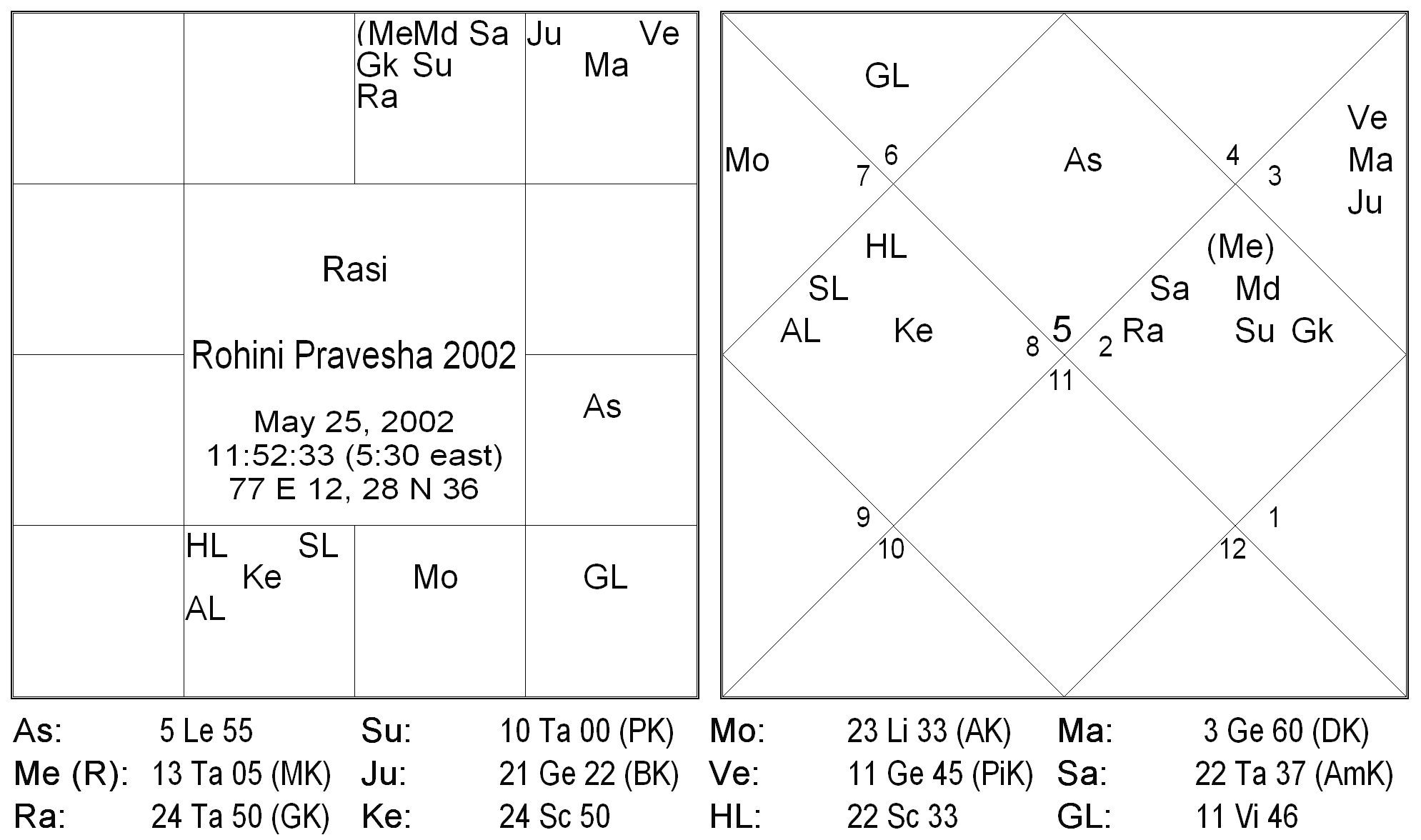
Example 1: this year (2002), the Sun chart for the entry of the Sun into Rohini nakshatra is drawn. If on the very day of its entry (day-1), a brief shower or rain is noticed in any region, then predict that the monsoon shall commence 72 days thereafter. Since the date of entry is May 25 2002, then the 72nd day will be August 25 2002[2]. It is evident that this requires a genuine observation of rainfall and that this has to be noted for major villages in a region before a final conclusion is drawn for the region as a whole. This is a late monsoon and the farmers will have to be advised to depend on irrigation facilities and accordingly time their sowing.
Example 2: If some rainfall is noticed on the ninth day from the date of Rohini Pravesh, then rainfall should be predicted from the 28th day thereafter. The ninth day reckoned from May 25 2002 is June 2 2002. The 28th day reckoned from this date is June 29, 2002 and this is the day the Monsoon will begin. This is an early monsoon and hence the farmers will have to be forewarned to quickly sow the seeds and be prepared.
#2: Excess Heat
If during the Sun’s passage of Rohini nakshatra excessive heat is noticed, then predict that during the forthcoming monsoon/rainy season ample rainfall shall occur.
#3: Flash Floods
If heavy rainfall (like those causing flash floods) occurs during the Sun’s passage of Rohini nakshatra, then during the subsequent monsoon/rainy season excellent/adequate rainfall shall occur.
#4: Drizzle
If low rainfall or just meager showers with moderate temperatures occur during the Sun’s passage of Rohini nakshatra, then during the subsequent monsoon/rainy season drought like conditions will prevail in the region with very low or meager rainfall. Suitable irrigation schemes will have to be launched and water will have to be managed carefully.
Assignment
- Get the meteorological data for (a) any station, (b) any district and (c) any country during the period of Rohini Transit and check the validity of the rules.
- What is the importance of Rohini Nakshatra and what is its link to rainfall?
Rohini Chakra
This Chakra is based on the tide factor. It is a well-known fact that the tide follows the Moon and the height of the tide is also proportional to the gravitational pull of the Moon. On days of the full Moon the tide is the highest as the Moon has a tremendous pull. The Moon indicates the tide and consequently rainfall. Its favorite nakshatra is Rohini, which is its Moolatrikona (office), although the exaltation of the moon occurs in Krittika Nakshatra (2° Taurus).
The longitude of the Moon (or simply Moon sign or star) at any point of time indicates the point of high tide and consequently, the point (or sign/star) in the seventh house from it also indicate high tide. The signs in the fourth/tenth from the Moon sign will indicate the low tide. If the high tide of the Moon indicates high rainfall, then the low tide signs/stars indicate low rainfall.
Drawing the Rohini Chakra
Two constellations from the Moon star are called Samudra (Sea), the next two are called तट (taṭa: bank, shore), the next one is called Parvata (mountain) and the next two are called Sandhi (junction)[3]. In this manner the 28 nakshatra (including the intercalary nakshatra Abhijit) are group into the four categories of samudra, tata, parvata & sandhi respectively.
Judgment of results
Draw a chart for Mesha Sankranti (solar ingress of sidereal Aries – used for Samvatsara determination). Count from Janma nakshatra to Rohini nakshatra. If Rohini nakshatra is in Samudra, predict excellent and adequate rainfall and excess harvest & grains. If Rohini nakshatra is in Tata, predict just adequate rainfall and sufficient harvest & grains. If Rohini is in Parvata, predict sporadic and meager rainfall with poor crops, low yield and shortage of food. If Rohini nakshatra is in sandhi, then predict draught or floods causing a bad harvest and
Example 3: New Delhi, Samvatsara Chakra (during 2002 AD). The Samvatsara Chakra is used for mundane astrology including the prediction of rainfall, drought, earthquakes etc. In the example, the Moon is in 13Ar17’ in Aswini nakshatra. Draw the Rohini Chakra for this Nakshatra.
Chart 2 New Delhi, Samvatsara Chakra
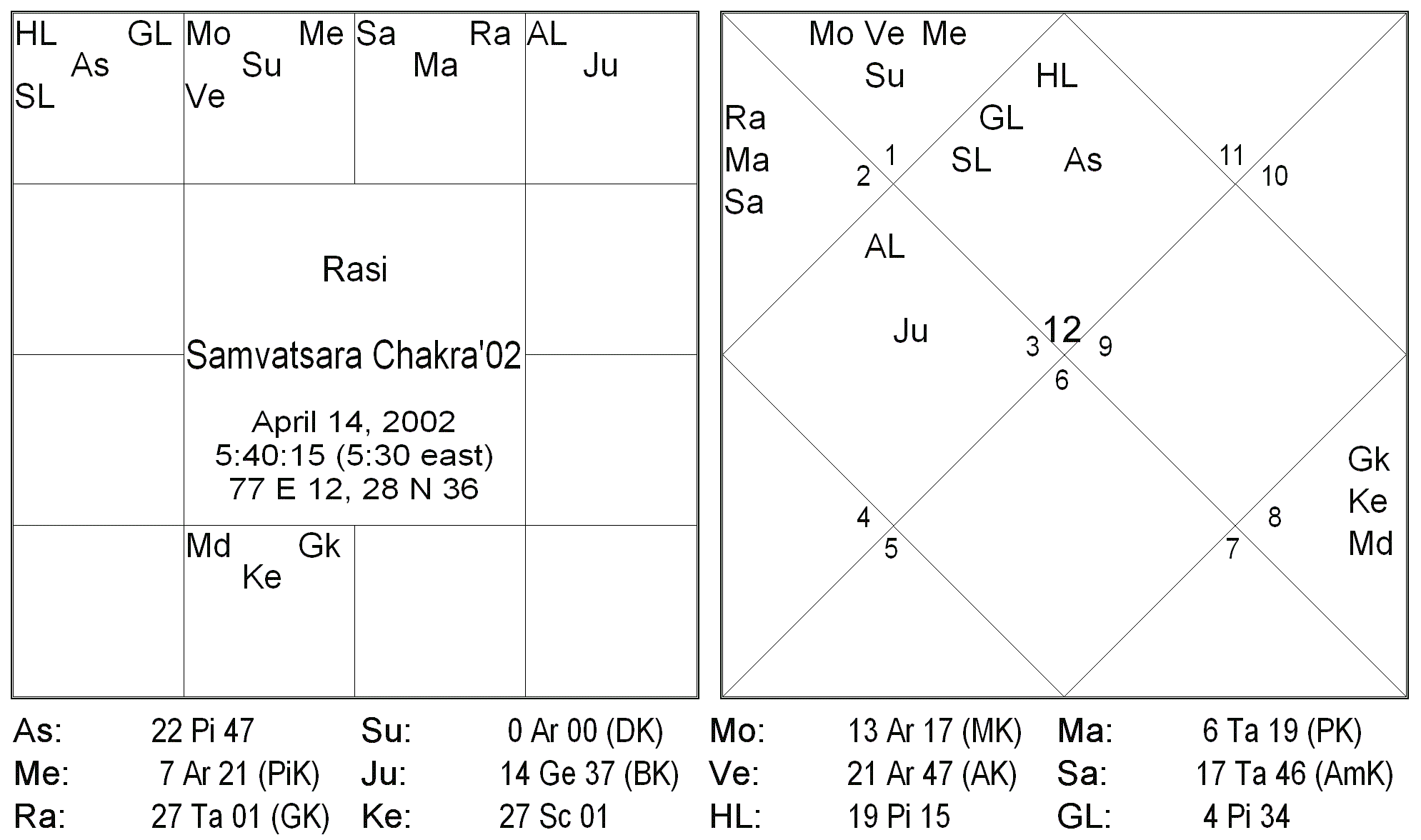
Table 2 Rohini Chakra Example 3
| Samudra (Sea) | Tata (Shore) | Parvata (Mountain) | Sandhi (Junction) | ||||
| 2 | 2 | 1 | 2 | ||||
| Ashvini | Bharani | Krittika | Rohini | Mrigashira | Ardra | Punarvasu | |
| Pushya | Ashlesha | Magha | Purva Phalguni | Uttara Phalguni | Hasta | Chitra | |
| Swati | Vishakha | Anuradha | Jyeshtha | Mula | Purva Ashadha | Uttara Ashadha | |
| Abhijit | Shravan | Dhanistha | Satabishak | Purva Bhadrapad | Uttara Bhadrapad | Revati | |
Rohini is in the second column in Tata (Bank/shore) indicating just about sufficient rainfall and that there will be adequate rainfall in the world.
Simple rule: This calculation can also be done in a simple manner by counting from the Janma nakshatra to Rohini, expunging multiples of 7 and then reckoning the position of Rohini. If the remainder is 1-2 the result indicates Samudra; if 3-4 Tata; if 5 Parvata and if 6,7 or 0 Sandhi
Example 2: Determine the rainfall for India in 2002. The same chart-2 is used. The Janma Nakshatra is Aswini (1). Counting from this to Rohini (4), we get four (4) both inclusive. This indicates Tata (bank/shore) indicating just about sufficient rainfall and that there will be adequate rainfall and harvest will be just sufficient.
Now, for India as a region, consider the Lagna nakshatra. Lagna is in Pisces, which is an ubhayodaya rasi while its Lord Jupiter is in Gemini. The results of the Lagna shall be felt in the middle (or beginning) while that of the Lagna lord shall be felt later. Lagna is at 22Pi49’ in Revati (28) nakshatra. Counting from here to Rohini (4) both inclusive, we get five (5) indicating Parvata or that in the beginning there shall be drought like conditions. The Lagna lord Jupiter is at 14Ge37’ in Ardra (6) nakshatra. Counting from here to Rohini (4) both inclusive, we get twenty-seven (27). Expunging multiples of 7, the remainder is six (6) that is a Sandhi, confirming that there shall be drought like conditions and flash floods in some regions.
It is noteworthy that in the middle of the year there were various announcements of drought and every part of India either feared drought while parts of Bihar had flash floods and loss of lives! However, later the Monsoon picked up and there is just about sufficient rainfall for adequate harvest and food.
Assignment
- Determine the Mesha Sankranti chart for any nation and determine its results for any given year in the past. Compare this to the actual rainfall for the year.
- Predict the rainfall for next year (2003) for three countries and compare this to the rainfall that will happen next year.
Sapta Nädi Vedha Chakra
Chart 3 Sapta Nädi Chakra
| Saturn | Sun | Mars | Jupiter | Venus | Mercury | Moon | |
| Nakshatra | Krittika | Rohini | Mrigashira | Aridra | Punarvasu | Pushya | Ashlesha |
| Vishakha | Swati | Chitra | Hasta | Uttara Phalguni | Purva Phalguni | Magha | |
| Anuradha | Jyeshtha | Mula | Purva Ashadha | Uttara Ashadha | Abhijit | Shravan | |
| Bharani | Ashvini | Revati | Uttara Bhadrapad | Purva Bhadrapad | Satabishak | Dhanistha | |
| Nädi | Chanda | Väta | Dahana | Saumya | Nira | Jala | Amrita |
| Bhäga | Yama | Madhya | Soumya | ||||
Starting from Krittika nakshatra the twenty eight nakshatra (including Abhijit) are placed in the seven Nädi in the snake order (Sarpa gati[4]) moving forward and then reverse. A group of four nakshatra constitute a Nädi.
- Chanda Nädi: The group of four nakshatra Krittika, Vishakha, Anuradha & Bharini fall in this category. Saturn represents this Nädi. Chanda means fierce, violent, cruel, impetuous, hot, and angry; The Harivamsa refers to it as a demon causing diseases while the Matsya Purana uses this to describe the clouds that cause the deluge (drowning) of the earth. Devi Mahatmya refers to this as one of the eight sakti of Durga and its use in Mahisasura killing. As such this is a violent and very destructive nadi causing excess heat and wind.
- Vata Nädi: The group of four nakshatra Rohini, Swati, Jyestha & Aswini fall in this category, which is represented by the Sun. Vata refers to the Wind-God (Vayu) and indicates strong winds that blow away rain clouds. Thus, this is also a violent nadi causing strong wind.
- Dahana Nädi: The group of four nakshatra Mrigashira, Chitra, Moola & Revati fall in this category, which is represented by the Mars. Dahana means burning, consuming by fire, scorching, destroying and specifically refers to the Fire-God (Agni). This is a violent and destructive Nädi causing by excess heat.
- Saumya Nädi: The group of four nakshatra Ardra, Hasta, Poorvasadha and Uttar Bhadrapada fall in this category. Jupiter represents this nadi. Saumya means placid, gentle or mild and refers to the Soma juice[5]. As describing a mood it indicates happy, pleasant, cheerful and also a worshipper or an adherent. This is a pleasant, non-destructive nadi causing mild temperatures and moderate breeze.
- Nira Nädi: The group of four nakshatra Punarvasu, Uttar Phalguni, Uttarasadha & Poorva Bhadrapada falls in this category, which is represented by the Venus. Nira means juice or liquor and also refers to water. This is a benevolent nadi causing some water/fluid (humidity) in the atmosphere.
- Jala Nädi: The group of four nakshatra Pushya, Poorva Phalguni, Abhijit & Satabhisaj fall in this category, which is represented by the Mercury. Jala specifically means water. This is a benign Nädi causing rain and distributing water over the planet causing the greenery to flourish.
- Amrita Nädi: The group of four nakshatra Ashlesha, Magha, Shravana & Dhanistha fall in this category, which is represented by the Moon. Amrita means ‘life rejuvenating nectar’ and refers to water for human beings and as such to those liquids and juices that rejuvenate life or cause life to sustain. This is a very beneficial nadi causing water.
The nädis are further grouped into three parts called Bhaga. The middle Saumya nadi is called Madhya (literally ‘middle’) while the three nadi prior to it are called Yama Bhaga and the three succeeding it are called Saumya Bhaga. Yama is the God of death and the three Chanda, Väta & Dahana nadi belong to the portion presided by Yama (represented by Saturn). Sauma is the Moon-God who rejuvenates and sustains life and the three Nira, Jala and Amrita nadi belong to the portion presided by Sauma (represented by the Moon).
Judgment of Results
- If malefic planets are in the Yama portion and benefic planets in the Saumya portion, then mediocre results obtain for the year.
- If either of benefic or malefic planets are in the Madhya (middle) portion, then the nature of the planet shall dictate its result.
- Planets in Chanda nadi indicate extreme winds and heat.
- Planets in Väta nadi indicate strong winds, hurricanes etc, but no heat.
- Planets in Dahana nadi indicate tremendous heat but low winds.
- Planets in Saumya nadi indicate a pleasant weather.
- Planets in Nira nadi indicate some humidity and mild to moderate rain.
- Planets in Jala nadi specifically indicate rainfall, especially if it is the Moon.
- Even one planet in Amrita nadi gives substantial rainfall for the year.
- Planets in their own nadi show profound increase in the indications of the nadi. For example if Mars is in Dahana (heat) nadi, we should expect excess heat with low or stagnant wind.
- Determine the nakshatra occupied by the Moon and the nadi this nakshatra is in. If the Moon conjoins/aspects the lord of the nadi, then there shall be rainfall. This is sure to happen during a full Moon.
- The Moon in Amrita nadi and three other planets in Amrita nadi indicate rain throughout the day; four planets in Amrita nadi indicate rain for three days consecutively, five planets in Amrita nadi indicate rain for seven days consecutively and if all planets are in Amrita nadi, the whole earth has rainfall and appears like an ocean!
- The Moon in Jala Nadi and three other planets also in Jala nadi indicates rain for half a day; five planets also in Jala nadi indicates rain for five days.
- The Moon in Nira nadi and three other planets also in Nira nadi indicates rain for one Prahara (3 hours); four planets instead indicates rain for half a day; five planets instead in Nira nadi indicates rain for three days.
- If all planets other than the Moon are in Amrita nadi then it rains consecutively for 18 days; if instead they are in Jala nadi, it rains for 12 days and if in Nira nadi the rainfall is for 6 days.
- If all planets are in the Saumya Bhaga then at least 3 days rainfall is observed whereas if the malefic planets are in Yama Bhaga, then shortage of rain occurs.
- If all planets other than the Moon are in Dahana, Väta or Chanda nadi, excessive heat and strong winds cause and the earth to dry up.
- If malefic planets conjoin/associate with the Moon & Venus, even if other indications like their presence in Saumya portion (Nira, Jala or Amrita nädis) are for good rainfall, there will be a shortage of rain. On the other hand benefic planets influencing Venus & Moon indicate rainfall even if they are in Yama portion (Chanda, Väta & Dahana Nadi).
- The various traditional tools for timing should be used. These include (a) the moment of retrogression & direct motion (especially of Saturn & Jupiter) or (b) the time of Sunrise (udaya käla) which can be used for the day or (c) the moment of solar ingress into a sign called Sankranti which can be used for the predictions for the month while the Mesha Sankranti can be used for the year itself, or (d) the natural seasons ruled by the six planets with the Sun indicating specifically for the year etc.
Example 4: Predict the seasons using the Samvatsara Chakra
The Samvatsara chakra will always have the Sun at zero degrees in Aries in Aswini nakshatra and hence this effect is to be ignored. The remaining six planets as per 19 (d) above are used to predict the seasons.
Refer to Chart-2: The Saptanädi Vedha Chakra is given below
| Saturn | Sun | Mars | Jupiter | Venus | Mercury | Moon | |||||||||
| Nakshatra | Krittika
MARS |
Rohini
SAT |
Mrigashira
RAHU |
Aridra
JUP |
Punarvasu | Pushya | Ashlesha | ||||||||
| Vishakha | Swati | Chitra | Hasta | Uttara Phalguni | Purva Phalguni | Magha | |||||||||
| Anuradha | Jyeshtha
KET |
Mula | Purva Ashadha | Uttara Ashadha | Abhijit | Shravan | |||||||||
| Bharani
VEN |
Ashvini
MOON, MERC, SUN |
Revati
LAG |
Uttara Bhadrapad | Purva Bhadrapad | Satabishak | Dhanistha | |||||||||
| Nadi | Chanda | Vata | Dahana | Saumya | Nira | Jala | Amrita | ||||||||
| Bhaga | Yama | Madhya | Soumya | ||||||||||||
The aspects to the planets are seen as per the Sarvatobhadra chakra. As an example, let us examine the Moon to determine the rainy season.
Figure 1 Sarvatobhadra chakra showing aspects on Aswini
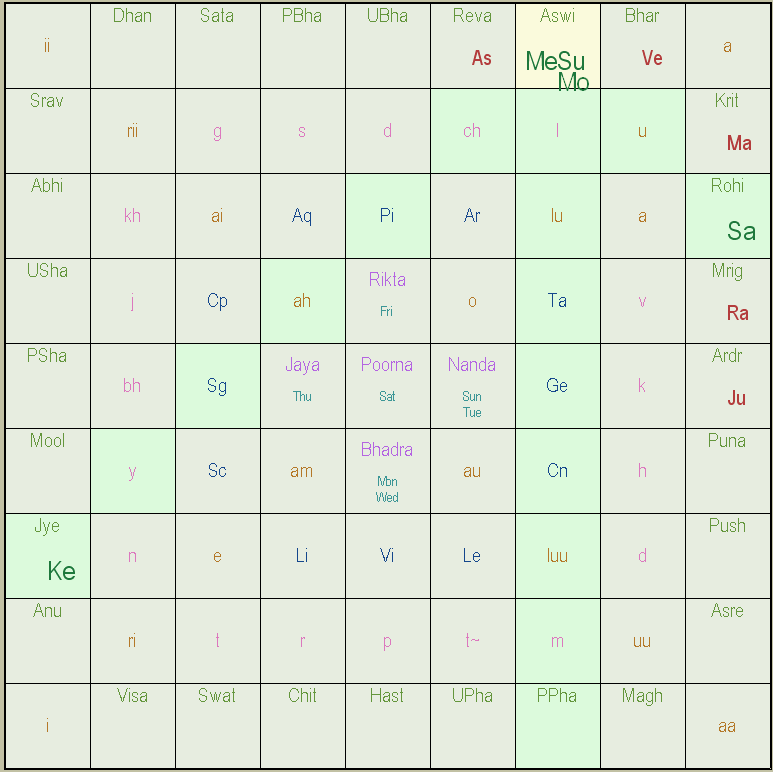
The Moon is placed in a Vata nadi, which should normally indicate scanty rainfall. Lord of Vata nadi is the Sun and it conjoins the Moon indicating excellent rainfall in the year. [Rule 11 above]
The Moon is also ill aspected by Saturn & Ketu from Rohini & Jyeshtha respectively indicating fears and initial shortages i.e. the rainfall maybe delayed (Saturn). However it is well conjoined by natural benefic Mercury indicating that there shall be sufficient water for the crops. Venus is ill placed in a Dahana nadi and is ill aspected by Mars showing some trouble to the seeds and crops due to excess heat and wind in the initial months of monsoon. [Rule 18 above].
Assignment
- Investigate the other methods for prognostication and determine how you will use this knowledge for each season, month and day.
- Try to predict tomorrow’s weather and keep a list of the right and wrong predictions. Pat yourself for a good prediction and try to find out the errors you made in the wrong predictions. Try to predict the exact time rain would start on a particular day. Late Pt. Ramesh Bhattacharya could do this, and so can you with some practice.
- What are the other methods for predicting rainfall? Have you investigated this area at all? Take a look at the classics and maybe you will find some clues and tools.
Footnotes
[1] Literally Solar ingress of Rohini nakshatra chart.[2] May 6 days + June 30 + July 31 + August 25 = 72 days.
[3] Pronounced samudra taṭa parvata & sandhi respectively
[4] Sarpa gati indicates moving onwards and then reverse as the table progresses.
[5] A kind of nectar emanating from the Moon (Mind) or like the Moon and referring to the Moon-God
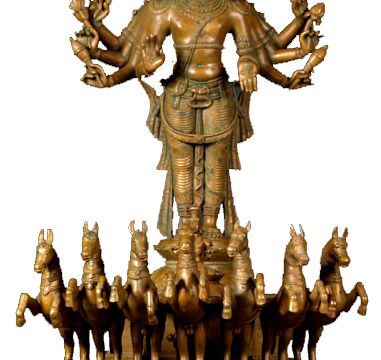

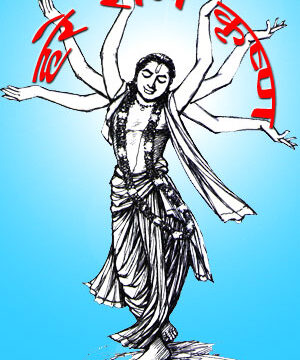

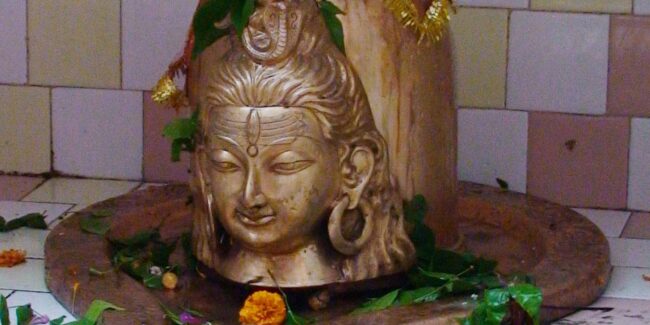
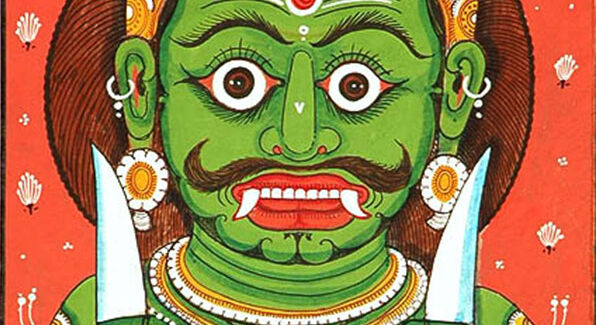
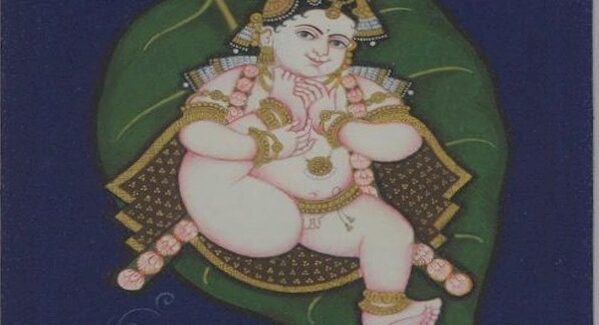
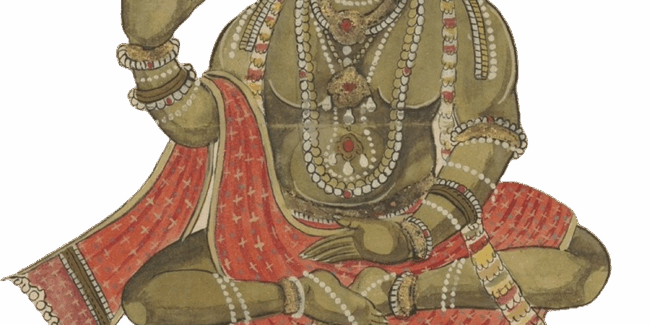
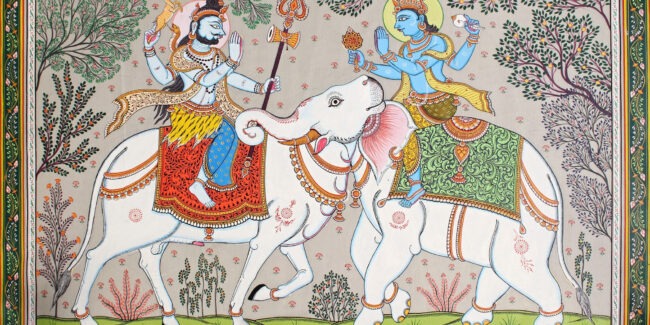
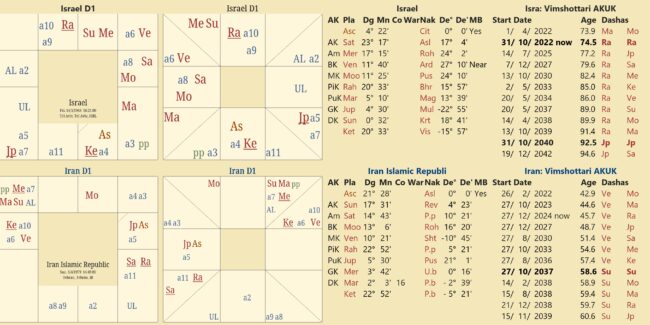


 DBC offers online courses in jyotish (Vedic Astrology) taught directly by Sanjay Rath as per the tradition, through narrated power points and other audio tools. The courses are at different levels, from the beginners through the intermediate to the advanced and are known as SoHamsa | DBC courses, with individual classrooms and assistant teachers
DBC offers online courses in jyotish (Vedic Astrology) taught directly by Sanjay Rath as per the tradition, through narrated power points and other audio tools. The courses are at different levels, from the beginners through the intermediate to the advanced and are known as SoHamsa | DBC courses, with individual classrooms and assistant teachers
 Sagittarius Publications is the publisher and distributor the popular quaterly magazine the Jyotish Digest, as well as many thorough books on the subject of Vedic Astrology or Jyotish.
Sagittarius Publications is the publisher and distributor the popular quaterly magazine the Jyotish Digest, as well as many thorough books on the subject of Vedic Astrology or Jyotish. We have an excellent pandit Divākar ‘Deva’ Mishra, who is from the priests of Vindhyāvāsini Siddha Pīṭha to guide you through the hundreds of temples of Kāśi [Varanasi] and neighbouring regions. He can organise your pūjā, keep you safe and take care. He is supported by an English-speaking well-travelled spouse ‘Supriya Mishra’. Please contact them directly for any services, remedial pūjā and tours. They handled the 60+ member Kāśi Jyotiṣa Group 2022.
We have an excellent pandit Divākar ‘Deva’ Mishra, who is from the priests of Vindhyāvāsini Siddha Pīṭha to guide you through the hundreds of temples of Kāśi [Varanasi] and neighbouring regions. He can organise your pūjā, keep you safe and take care. He is supported by an English-speaking well-travelled spouse ‘Supriya Mishra’. Please contact them directly for any services, remedial pūjā and tours. They handled the 60+ member Kāśi Jyotiṣa Group 2022.